Tis the season to celebrate euphorbias, since many of us will be living with or gifting/regifting one of its tribe over the next couple weeks, the poinsettia. Call me scrooge, but I’d much rather think about the ones planted in my garden than the holiday favorite with the flaming red bracts. Since first digging the garden 26 years ago, there’s always been at least a couple euphorbias around, and that will certainly be true again for 2015. I’m referring to the herbaceous and shrubby kinds, not the succulents, whose numbers are legion. This genus is ginormous, the largest genera of flowering plants in the plant kingdom, named after Euphorbus, physician to the Mauretanian King Juba II (first century B.C.), whose exploitation of its medicinal properties earned him a place in botanical nomenclature. But the white sap is notoriously toxic and the stinging enemy to the mucous membranes of the eyes and mouth, so I can’t imagine how and in what form Dr. Euphorbus delivered the medicine. Even getting the sap on the skin causes a strong reaction in some people, though I seem to have the hide of a rhino and haven’t had a problem so far. I’ve grown many of the different herbaceous kinds over the years, which generally tend to be short-lived for me. Many will seed around, whether lightly or alarmingly, and species do occasionally cross, like the famous Euphorbia x martinii, a naturally occurring hybrid between characias and amygdaloides. The euphorbias are standouts here in winter and spring for a sunny, dryish garden, and I’ve long been faithfully trying out any new kinds that come my way.
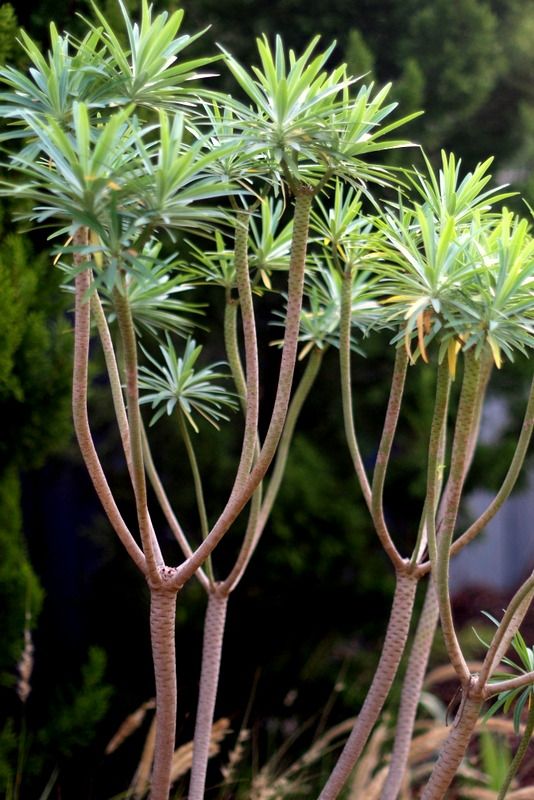
First the euphorbs returning for 2015. There’s tree-like Euphorbia lambii fattening up after the recent rain, losing its scrawny summer looks. This euphorbia seeds around like nobody’s business. But it’s tall, incredibly tough and tolerant of a dry summer, so it gets a pass. Hardy down to 25 to 30 degrees.

By February it will look more like this (February 2013)
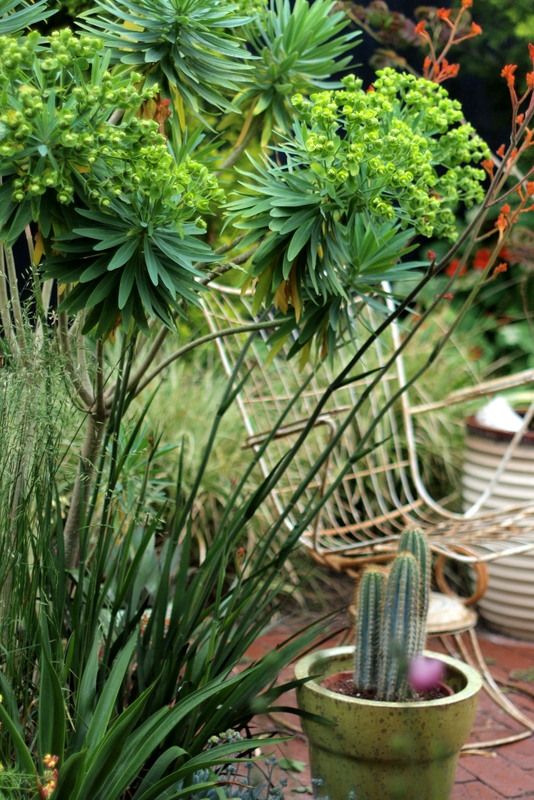
In bloom April 2013, illustrating a euphorbia’s attractions: smooth, blue-green leaves arranged in whorls with a shaggy chartreuse inflorescence
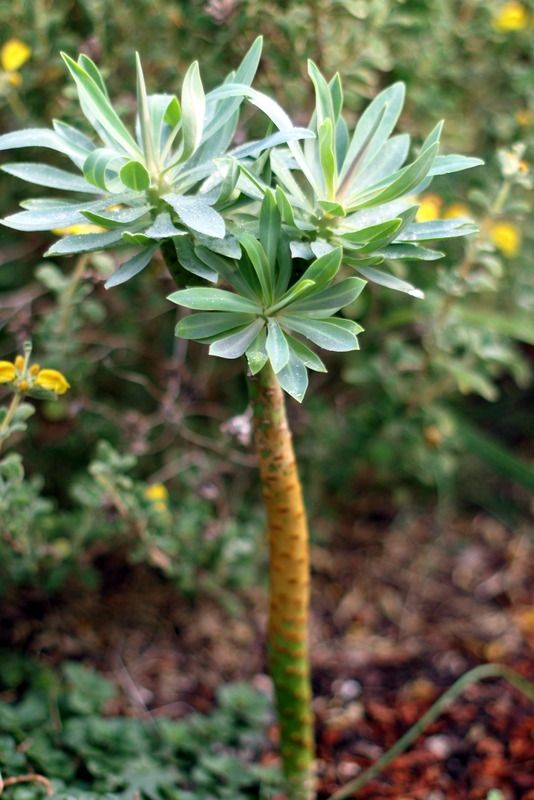
Also fattening up is a young E. atropurpurea. After a wobbly first year, it’s exciting to see it settling in and appearing to choose life. From Tenerife, Canary Islands.
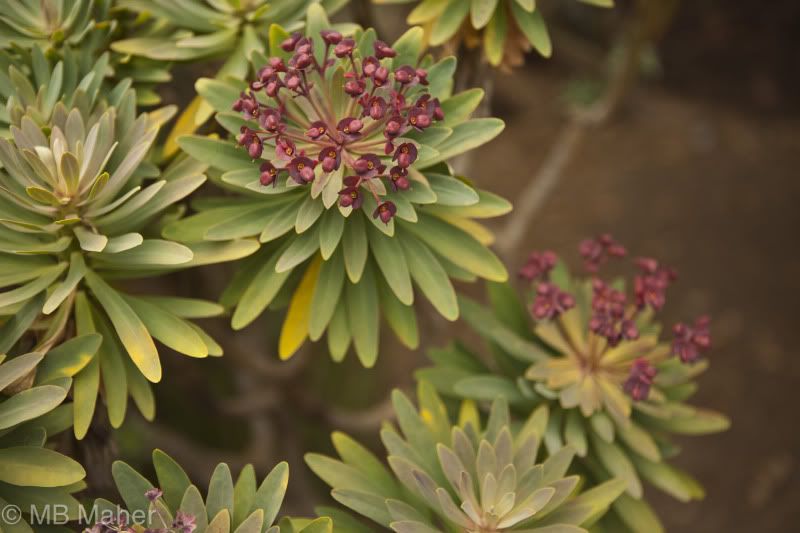
Here it is at the Huntington Botanical Garden, flaunting its atypically fabulous wine-colored bracts. I had never heard of such a euphorbia before and stood slack-jawed before it when first stumbling across this beauty.

There was much gaping and sputtering, and then a frenzied search for my son Mitch, who was photographing barrel cactus elsewhere in the garden (see here). I dragged him back by the sleeve to take this photo. And then I chased this euphorbia across a summer of plant shows, ultimately finding a source at Annie’s Annuals. Bless you, Annie!
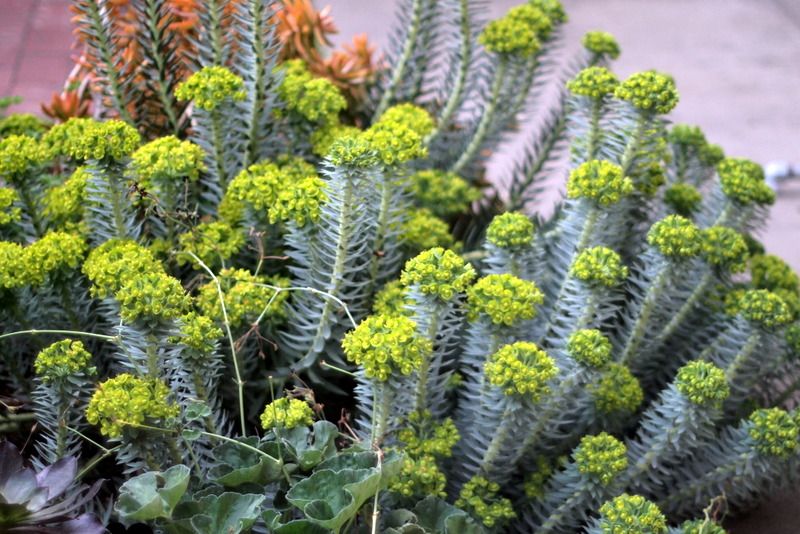
Also returning is Euphorbia rigida, just not this specific plant, which declined and withered away. A couple pieces were salvaged. It also reseeds, but nowhere at the level of E. lambii. When I find these seedlings, they’re carefully potted up. Photo from February 2014
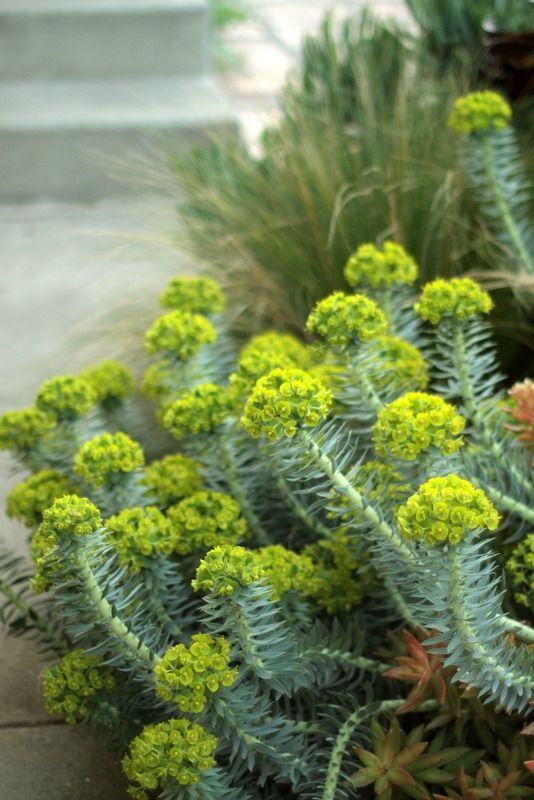
spring 2012. So this plant lived at least three to four years. The clay here might have something to do with the shortened lifespan.
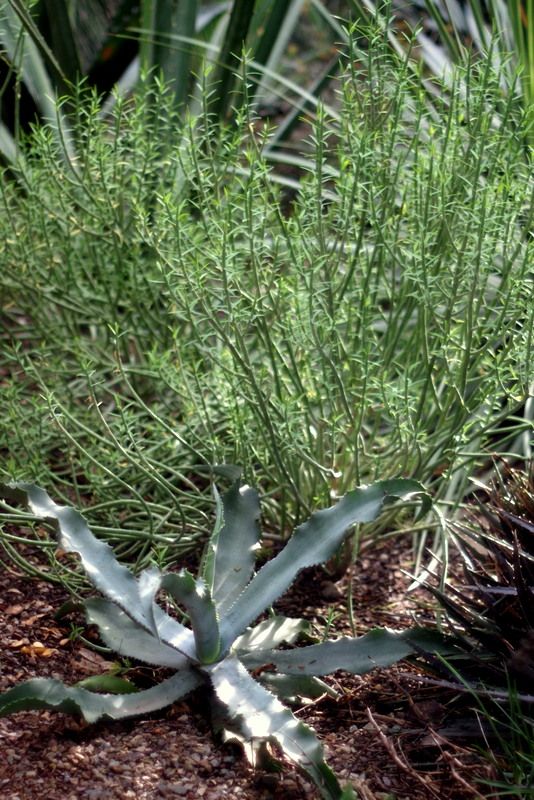
Euphorbia mauritanica in the front garden, where the sun/shade shifts around quite a bit throughout the year. These are probably leggier than they should be, but I’m hoping they’re in shape for a good bloom this spring.
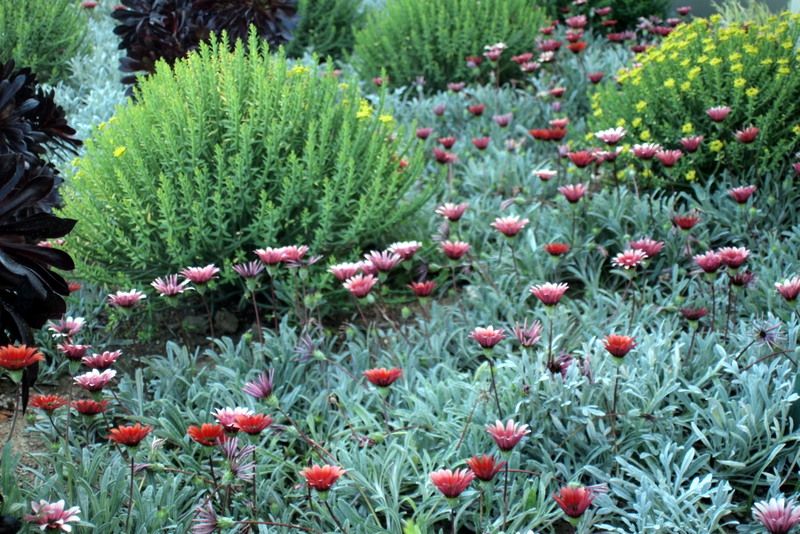
Here’s the ideal Euphorbia mauritanica, included in a design by Dustin Gimbel.
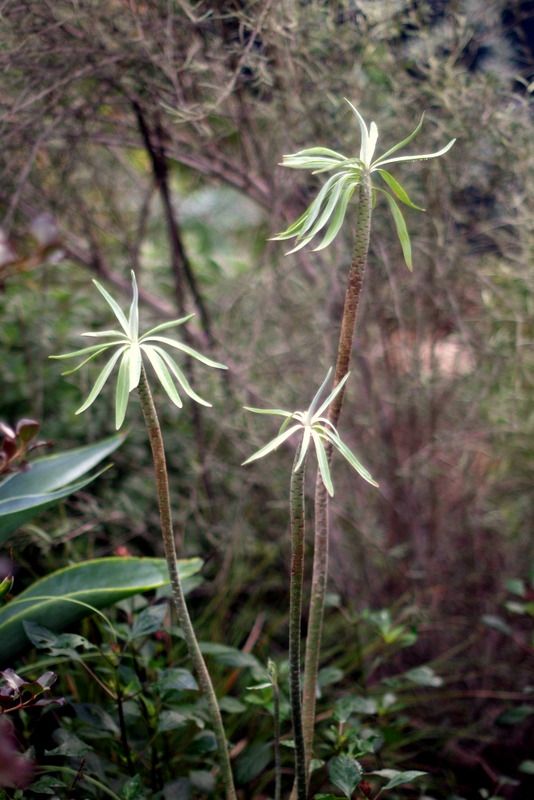
My straggly Euphorbia ceratocarpa, appearing to have barely survived a recent move to clear out the compost area.

Old photo from 2009 when the smoke tree ‘Grace’ ruled the garden and I continually wore that green robe through the winter. Euphorbia ceratocarpa is on the left against the fence. Golden blur on the right was a duranta.
Unfortunately, this is the best photo I have to illustrate why I’ve carefully nurtured this one ratty-looking plant from a single cutting for the many years after the mother plant died. There’s very little information available on this euphorbia for gardens. English plantsman John Raven grew it, and his daughter Sarah Raven has this to say:
“This is one of the most open-growing and perhaps less elegant of the euphorbias, forming big, rangy clumps nearly 1.8m (6ft) across. But it is definitely a contender for the longest-flowering plant I know. I’ve had one that is yet to stop blooming outside the kitchen at Perch Hill since March 2006. It has not had a single week’s pause, and you can pick decent-sized stems right the way through the winter. I cut some for an arrangement at Christmas, when there is almost nothing of this brightness still surviving. E. ceratocarpa is also very easy to propagate. The cuttings that my parents collected all took extremely easily – even after several days wrapped up in damp loo roll in a plastic bag – and those few plants have created many thousand since. This euphorbia should certainly be more widely grown.” – source here.
Easy to propagate? Ha! I’ve had cuttings take a year to root. The only other person I’ve come across who grows it is garden designer/author Rebecca Sweet. It reminds me of a big, blowsy, lime-green hydrangea when in bloom.
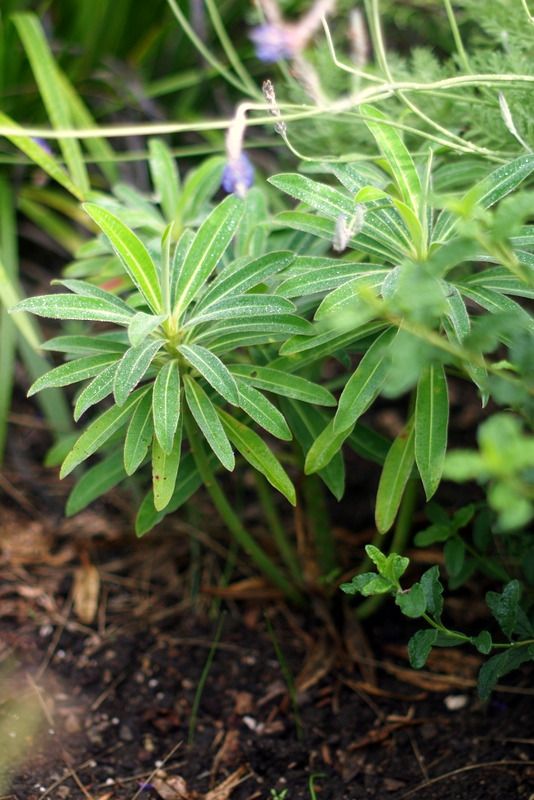
Euphorbia mellifera is another big shrub like E. lambii, but more lush. Fairly fast growing, this one was planted out from a 4-inch pot last year. For zones 9 to 11 or container culture. Reseeds lightly here.

And then there was the moment when the pale, variegated euphorbias entered our lives. ‘Tasmanian Tiger,’ discovered in a garden in Tasmania in 1993, was the first. Because they turned up at the local nurseries, I grabbed a couple this fall to plant near Leucadendron ‘Ebony’ while it gains size. Short-lived plants have their uses too.
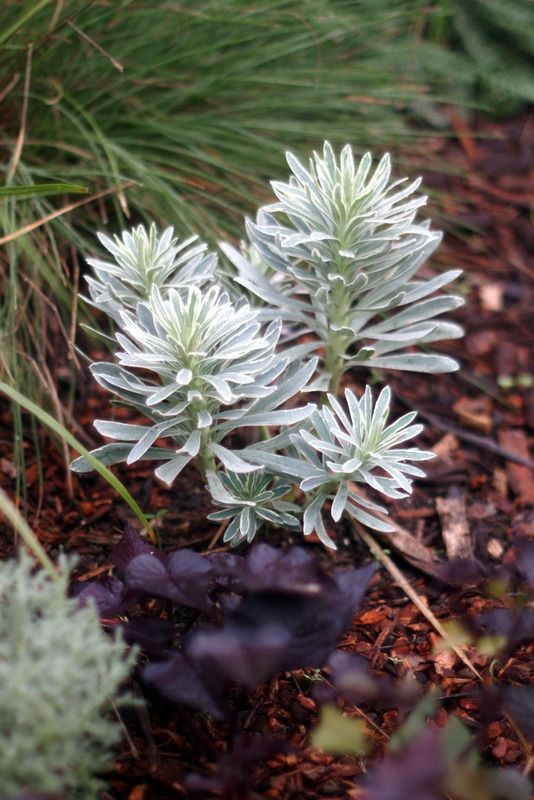
I tend to try all the pale variegated ones. Some have proved to be stronger growers than ‘Tasmanian Tiger.’ A new one to me, at the nurseries this fall, under Native Sons label, E. characias ‘Glacier Blue’
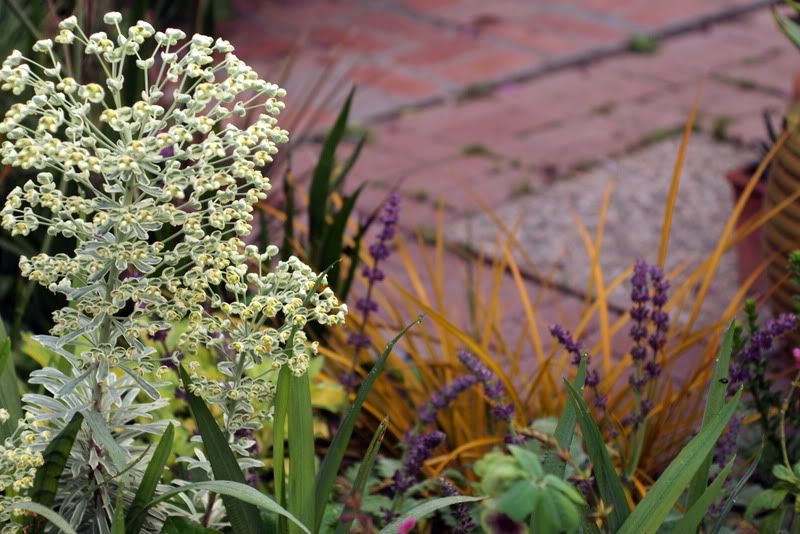
An old photo of a bloom truss from Euphorbia characias ‘Silver Swan,’ which I remember as a very robust grower.

This non-variegated form of E. characias turned up at local nurseries too this fall. Euphorbia characias ‘Black Pearl,’ so named because part of the flower structure has a “black eye.”

An old photo of a blooming Euphorbia x martinii ‘Ascot Rainbow,’ whose leaves have bright yellow variegation that flushes red with cool temps of fall/spring.
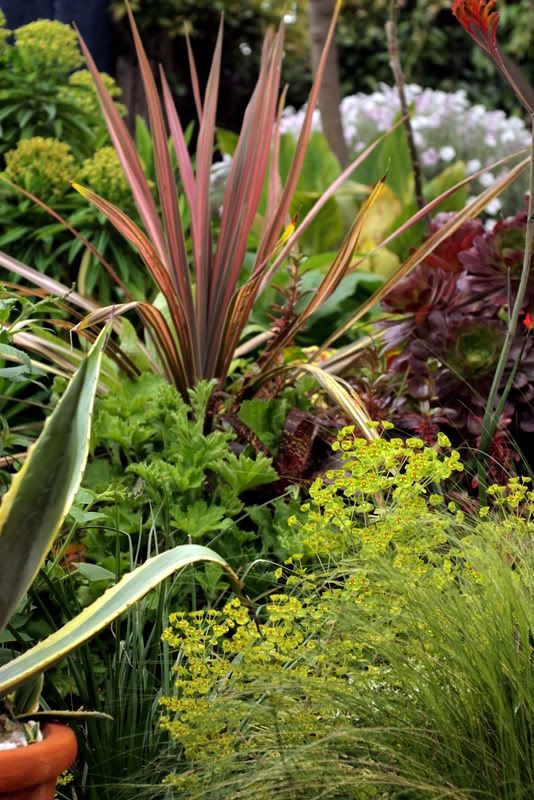
From April 2011, Euphorbia mellifera almost out of frame at the upper left, ‘Ascot Rainbow’ blooming lower right.
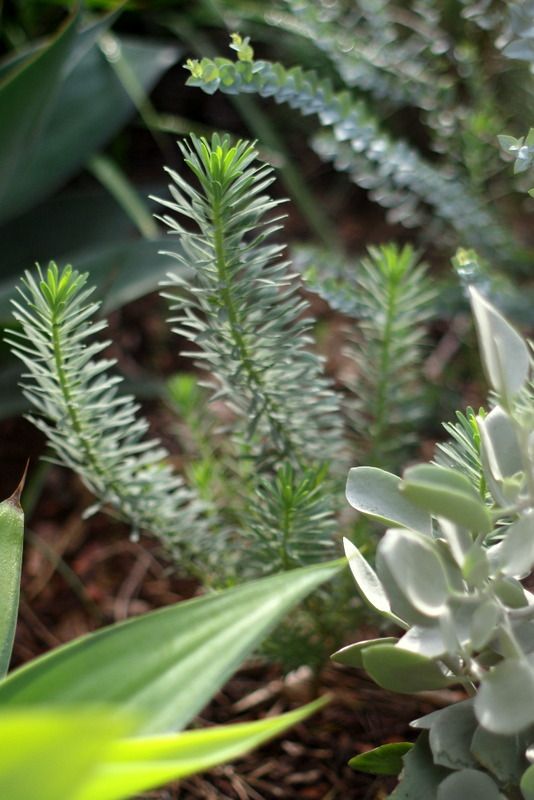
I’ll end with a photo of this incredibly weedy self-sower brought home years ago. Possibly Euphorbia nicaeensis. A nuisance, yes, but the fresh color and meticulous arrangement of the leaves keeps me from weeding every last one from the garden.
Enjoy (or give to your mother) your Euphorbia pulcherrima (poinsettia) this holiday season, and as alway, mind the sap!

Your beautiful post makes them very close to appealing.
I really love euphorbias, especially this kind. I´m experimenting with some native euphorbias that I find where I live as they are not demanding in my garden. It is nice to see so many different kinds in your garden.
Love the genus too, and we tend to grow many of the same species! The E. lambii doesn’t undergo quite the dramatic feast/famine foliage as for you, probably the more moderate summers here. E. atropurpurea is definitely a favorite of mine as well, and seems to be in bloom 8 months of the year here, but slow to bulk up the first year and a half. I’m surprised you didn’t include E. myrsinites or E. cotiniifolia, which I wish had more tolerance for a typical norcal winter. Fortunately Cotinus coggygria ‘Royal Smoke’ is almost as beautifully burgundy foliaged.
I’m stuck on that photo of you in the green robe, and that Cotinus!
@Hoov! And here I thought I was preaching to the choir. Not a fan? Euphorbia rigida would love your slope.
@Lisa, I bet there’s some interesting hybrids and crosses among your native ones.
@David, for me, E. rigida replaces myrsinites, which never gets beyond straggly here. And if you look at the photo of me in the robe, the twiggy branches coming in the right of the photo is an E. cotinifolia. Very brittle trees here. My last one snapped about two years ago, and they grow so fast I don’t keep them in containers. In the heat of summer it sounds like corn lightly popping when the seeds explode.
@Loree, I wore that robe to threads! From Ebay, it had green/white braid on the lapels, pockets.
I’ve been bitten by the Euphorbia bug as well, and grow, or attempt to grow, several species. My problem is getting them to make it through monsoon season. Of the three ‘Ascot Rainbow’ I planted last winter, only one is alive, but my wulfenii is thriving, and it is my favorite, but I won’t dwell on that lest I jinx it.
Les, all those hybrids like Ascot Rainbow, Helena’s Blush, etc, have been short-lived for me. So maybe it’s best to consider them as one-season annuals. Here they tend to get attacked by scale after a first season and usually weaken. Cuttings are easy, but I’d rather get stocky plants from local nurseries in fall. In fact, the longest-lived euphorb I have now is the tender lambii.
I do like the look of the herbaceous euphobias but have tried the odd one with no success. Your ‘weedy’ one looks alot like one of the ones I tried. Maybe I should give it another shot! 🙂
Great to hear of another obsessed Euphorbia lover. I’ve only been at it for 6 months triggered by a neighbor giving me a E. wufenii seedling. We’ve got a cottage in the hot/dry goldfields of central Victoria (heavy clay soil – great for roses), Australia, and a main home in Bayside Melbourne (v poor sandy soil) so I’ve got two different gardens in which to experiment. Have just ordered E. lambii so will be exciting to see how it goes. Also E. regis jubae coming soon. Dendroides coming soon. Going well so far with Amygdaloides var martinii, robbiae, just planted rigidi, myrsinites, Excalibar, cornigera, blue peaks, blue haze; copton ash looks good. Stigiama not growing yet. Love ’em all!
So cool to have both clay and sandy sites to experiment. I’m crossing my fingers that my clumps of E. mauritanica put on a good show this spring.